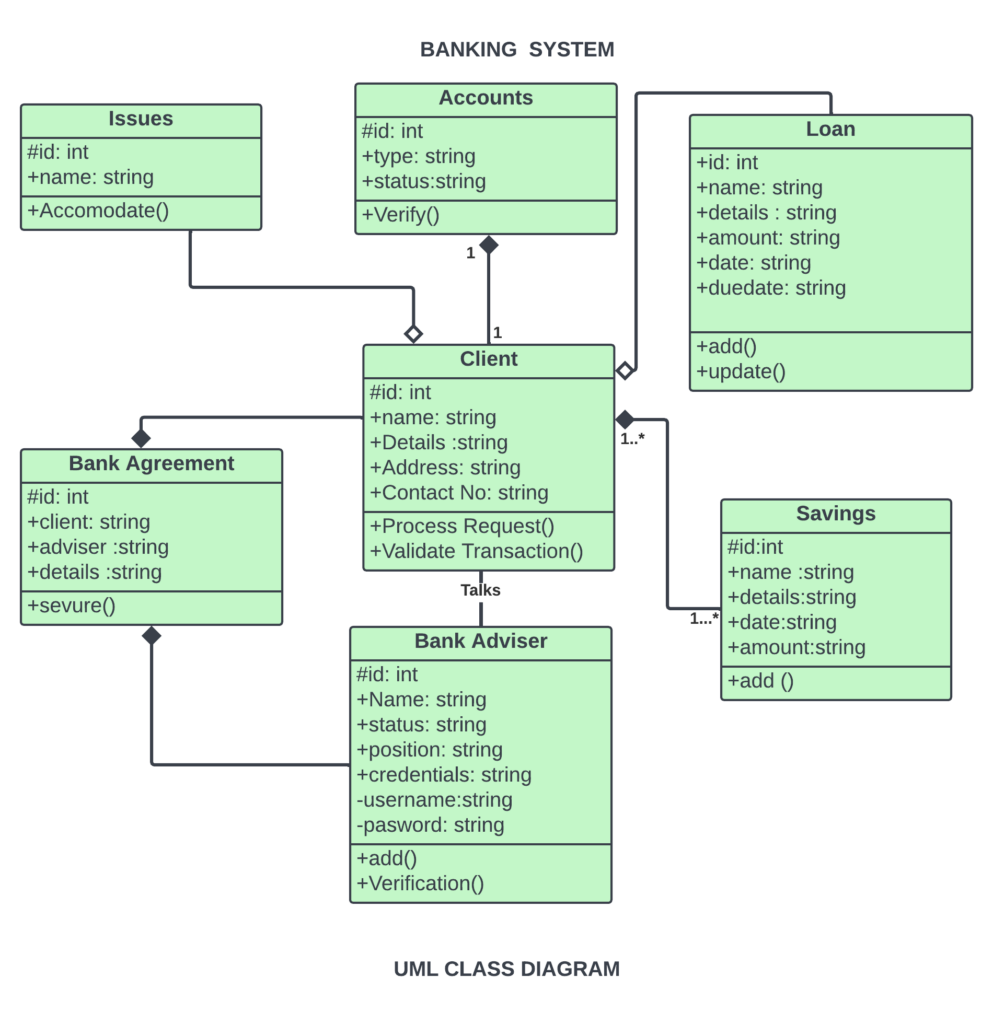The Banking System Class Diagram is used to show, explain, and write down the parts of a Banking System, which are called “classes.”
This diagram can also be used as a guide or as a way to write software code that can be run. It gives an overview of the classes, functions, and relationships in the Banking Management System.
A UML class diagram is very important when making a banking management. This is because the class diagrams are very good at showing the structure of the banking Management, including how each class is put together.
Class Diagram for Banking Management System: Details
The table shows the basic details of the class diagram of the Banking Management System. It has quick description details of the project.
| Name: | Banking System Class Diagram |
| Abstract: | The Banking System class diagram describes the methods and variables in an object, which is a program’s or unit of code’s representation of a certain entity. |
| UML Diagram: | Class Diagram |
| Users: | Employee, Customer, and Bank Admin |
| Tools Used: | Diagraming Tools that have UML Class Diagram Symbols |
| Designer: | Sourcecodehero.com |
What is the Banking System Class Diagram?
Class diagrams show how your system or subsystem is put together. Moreover, you can use class diagrams to model the objects that make up the system, show how the objects relate to each other, and explain what the objects do and what services they offer.
Finally, class diagrams are useful at many points in the process of making a system. The class diagram is presented in a rectangle with three partitions.
Then, the upper part is for the name of the class, the middle is for its attributes and the bottom is for the methods. These partitions will clearly emphasize the details of the classes.
What is the importance of the Banking System class diagram?
Class diagrams are the most important type of UML diagram, and they are an essential part of making software.
Furthermore, Class diagrams are the best way to show a system’s structure in detail, including its parts, how they work, and how they relate to each other.
The Banking System Class Diagram describes the structure of a Banking System class, their attributes, operations (or methods), and the relationships among objects.
The main classes of the Banking System are Customer, Employees, Accounts, Fixed Deposit, Saving Account, Current Account
How to Create or Draw a Banking System Class Diagram
Time needed: 3 minutes
Here are the steps on How to Create or Draw a Banking System Class Diagram
- Identify the class names
The first step is to figure out what the system’s main goals are.
- Identify relationships
The next step is to figure out how each class or object is linked to the others. Look for things they all have in common and things that make them different. Lastly, this will help you group them together when drawing the class diagram.
- Create the Structure
First, add the names of the classes and connect them using the right connectors. Attributes and functions/methods/operations can be added later.
The following are the access levels and the symbols that correlate to them:
Public (+)
Private (-)
Derived (/)
Protected (#)
Static (underlined)
Package (~)
Example of Simple Class Diagram for Online Banking System with Explanation
The Simple Class Diagram for Online Banking System with Explanation is given, along with an explanation of what it means.
In addition, this Class Diagram tells you everything you need to know about the class’s methods and properties.
It also shows how the system’s classes are related to each other. Also, here, I’ll show you an example of how to build a class diagram and match its attributes and methods.
This is made with a simple idea that comes from the common task of the Banking System.

The Banking Management System Class Diagram shows how the classes in the system are put together, as well as their attributes, operations (or methods), and how they relate to each other accounts, clients, bank agreements, Savings, loans, and issues are the main classes of the Banking System.
Generally, it resembles a flowchart in which classes are represented as boxes with three rectangles inside each box.
Additionally, the top rectangle contains the class’s name; also the middle rectangle contains the class’s properties; and lastly, the bottom rectangle contains the class’s methods, commonly known as operations.
Conclusion:
You need to know how the Banking System was designed and built using diagrams. That’s because you can’t make a system that works perfectly without it.
But if you make this class diagram, you’ll know what classes and situations the system should be able to handle. You will also find the necessary processes and link them to the other UML Diagrams.
The Banking System must have a designed diagram to define the classes needed for the desired outcome Moreover, it is used to model the parts of the system, show how they relate to each other, and describe what each object does and what services it offers.
Related Articles
- Data Flow Diagram for ATM System
- DFD for Banking System (DATA FLOW DIAGRAM)
- DFD of Bank Management System
- Banking System Use Case Diagram
- Hotel Management System Use Case Diagram
Inquiries
If you have inquiries or suggestions about Class Diagram for Online Banking System, just leave us your comments below. We would be glad to hear your concerns and suggestions and be part of your learning.
Keep us updated and Good day!
